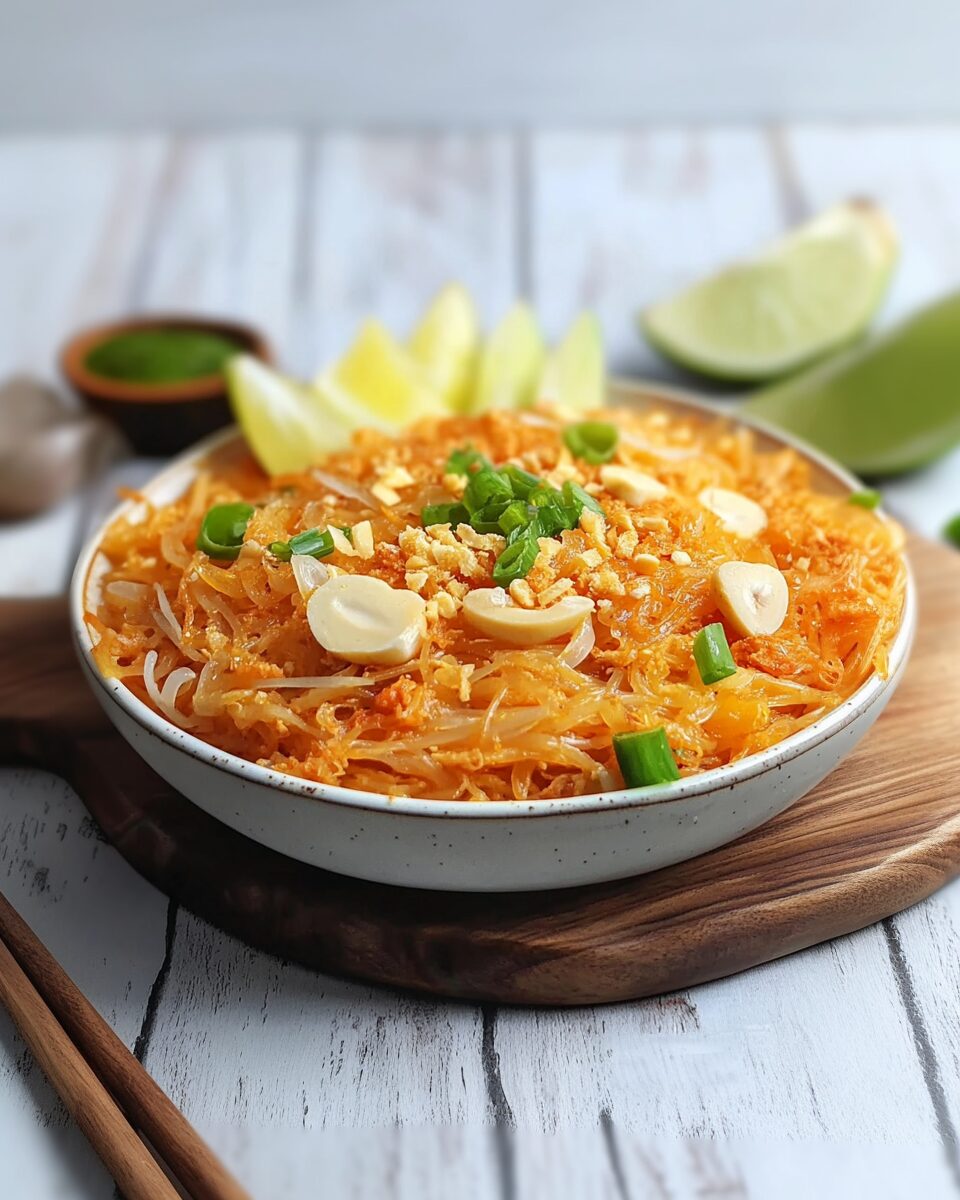Vegetarian Palabok is a plant-based twist on the classic Filipino noodle dish, Pancit Palabok. Traditionally made with shrimp and pork, this version utilizes tofu and vegan seasonings, offering a flavorful and healthier alternative without compromising on taste.
Full Recipe:
Ingredients
- Palabok noodles (cornstarch noodles) or spaghetti noodles
- Vegetable oil
- Sweet onions
- Garlic
- Annatto powder
- Tofu
- Vegan chicken seasoning
- Vegan fish sauce
- White sugar
- Vegetable broth or water
- Water
- Cornstarch
- Salt
- Ground black pepper
- Crispy garlic cloves
- Egg
- Scallions (green onions)
- Banana chips (optional)
- Lemon wedges
Directions
- Cook the noodles according to package instructions and strain.
- In a heated pan or pot, add oil and sauté sweet onions for 2 minutes.
- Add minced garlic and cook for another 30 seconds.
- Incorporate annatto powder, crumbled tofu, vegan chicken seasoning, vegan fish sauce, and white sugar. Mix well and cook for 2 minutes, stirring constantly.
- Pour in the vegetable broth and bring to a rapid boil. Reduce to a simmer for 10 minutes.
- In a small bowl, mix water and cornstarch, then add this mixture to the simmered sauce. Bring to a boil.
- Season the sauce with salt and ground black pepper to taste. Allow it to simmer for another minute until the desired consistency is achieved.
- Turn off the heat and pour the sauce over the cooked noodles. Mix well.
- Arrange the remaining ingredients on top: crispy garlic, sliced egg, scallions, and banana chips if using.
- Serve immediately with lemon wedges on the side.
Nutritional Facts
Note: Specific nutritional information for this recipe is not provided in the original source. However, based on similar vegetarian palabok recipes, a typical serving may contain approximately:
- Calories: Approximately 305 KCal
- Total Fat: 9g
- Carbohydrates: 39g
- Protein: 17g
The Origins of Palabok
Palabok is deeply rooted in Filipino culinary tradition, particularly in the regions of Luzon. The dish’s name is derived from the Filipino word “palabok,” which refers to the savory sauce that is typically made from shrimp broth, garlic, and annatto (achiote) to give the dish its vibrant orange color. Traditionally, the dish is served with rice noodles, topped with sautéed garlic, pork or shrimp, and a generous serving of hard-boiled eggs. While Palabok has evolved over time with various regional variations, its flavor profile and comforting qualities have remained consistent.
Over the years, the Filipino diaspora has helped introduce Palabok to international audiences, and it has since become a beloved dish not only in the Philippines but also in Filipino communities worldwide. The vegetarian version of Palabok is a recent innovation that caters to a growing demand for plant-based meals while still honoring the traditional flavors.
Why Choose Vegetarian Palabok?
The vegetarian version of Palabok offers several health benefits, making it an appealing option for those who follow a vegetarian or vegan lifestyle, or anyone looking to enjoy a lighter, plant-based meal.
-
Healthier Alternative: Vegetarian Palabok replaces the usual pork and shrimp with tofu, a plant-based protein that’s rich in essential nutrients, including iron and calcium. Tofu is an excellent source of plant protein and has a much lower fat content compared to traditional meat options. It also has fewer calories, making it a healthier alternative for those looking to manage their weight or reduce cholesterol intake.
-
Lower in Cholesterol and Saturated Fats: Traditional Palabok is often prepared with fatty pork or shrimp, which can be high in cholesterol and saturated fats. By using plant-based ingredients, such as tofu and vegetable broth, the vegetarian version of the dish significantly reduces cholesterol intake and promotes heart health.
-
Environmental Impact: Choosing plant-based meals is also beneficial for the environment. Meat production has a substantial ecological footprint, contributing to greenhouse gas emissions, deforestation, and water consumption. A vegetarian diet can help reduce environmental damage and is a sustainable alternative that aligns with global efforts to combat climate change.
-
Vegan-Friendly: Vegetarian Palabok is completely vegan, making it suitable for individuals who avoid animal products for ethical or dietary reasons. It’s also an excellent option for those who are lactose intolerant or have allergies to shellfish, offering a safe alternative to the traditional recipe.
-
Digestive Health: The use of fresh vegetables, tofu, and vegetable broth makes the vegetarian Palabok easier to digest compared to the more heavy, meat-laden original. The absence of greasy or fatty meat helps improve gut health and overall digestion.
A Flavorful and Satisfying Dish
One of the main appeals of Palabok, whether vegetarian or traditional, is its deep umami flavor. This comes from the savory and rich sauce that envelops the noodles. The vegetarian version achieves this by utilizing ingredients like vegetable broth, tofu, annatto powder, and vegan fish sauce, creating a sauce that mimics the savory richness of the original while remaining entirely plant-based.
The tofu in the vegetarian Palabok adds texture and protein, taking the place of shrimp or pork in the original recipe. The tofu absorbs the flavors of the sauce, resulting in a dish that is both hearty and satisfying. The crispy garlic, scallions, and optional banana chips add a nice crunch to the dish, creating a delightful contrast to the soft noodles and tofu. The lemon wedges served alongside the dish provide a refreshing citrusy balance that helps cut through the richness of the sauce.
Vegetarian Palabok as a Crowd-Pleaser
Despite being a vegetarian dish, Palabok remains a crowd favorite, especially for those who may not typically eat plant-based meals. The unique combination of textures—from the soft noodles to the crispy garlic and crunchy banana chips—makes this dish incredibly enjoyable. It’s also a versatile dish that can be customized to suit individual preferences. For example, if someone prefers more protein, additional tofu or a variety of plant-based protein sources can be added. For those who enjoy a spicier dish, a dash of chili can elevate the flavor profile.
Palabok is also a great option for gatherings, family meals, and even potlucks. It can be served as a main dish or as part of a larger Filipino spread. The vegetarian version of Palabok is just as satisfying and flavorful as its traditional counterpart, ensuring that everyone, whether vegetarian or not, will enjoy it.
How to Customize Vegetarian Palabok
One of the best things about vegetarian Palabok is its flexibility. The basic recipe can be easily adjusted to accommodate different dietary preferences and ingredients. Here are some ideas for customizing your vegetarian Palabok:
-
Add More Vegetables: If you want to increase the vegetable content, feel free to add sautéed spinach, mushrooms, or bell peppers to the dish. These vegetables not only enhance the flavor but also provide additional nutrients and fiber.
-
Use Different Noodles: Traditional Palabok is typically made with rice noodles, but you can also use other types of noodles such as whole wheat spaghetti or gluten-free noodles for a variation that suits dietary restrictions.
-
Make It Spicy: If you like a bit of heat, add a touch of chili flakes or fresh chili peppers to the sauce. This will give your dish an extra kick that pairs perfectly with the richness of the sauce.
-
Try a Different Protein Source: While tofu is the primary protein in vegetarian Palabok, other plant-based protein sources like tempeh or seitan can be used in place of tofu for a different texture and flavor profile.
Conclusion: A Delicious and Nutritious Meal for All
Vegetarian Palabok is a perfect example of how traditional Filipino dishes can be adapted to meet modern dietary preferences without compromising on flavor or texture. Whether you are a vegetarian, vegan, or someone simply looking for a healthier meal, this dish offers a satisfying and flavorful option that’s both nourishing and delicious.






